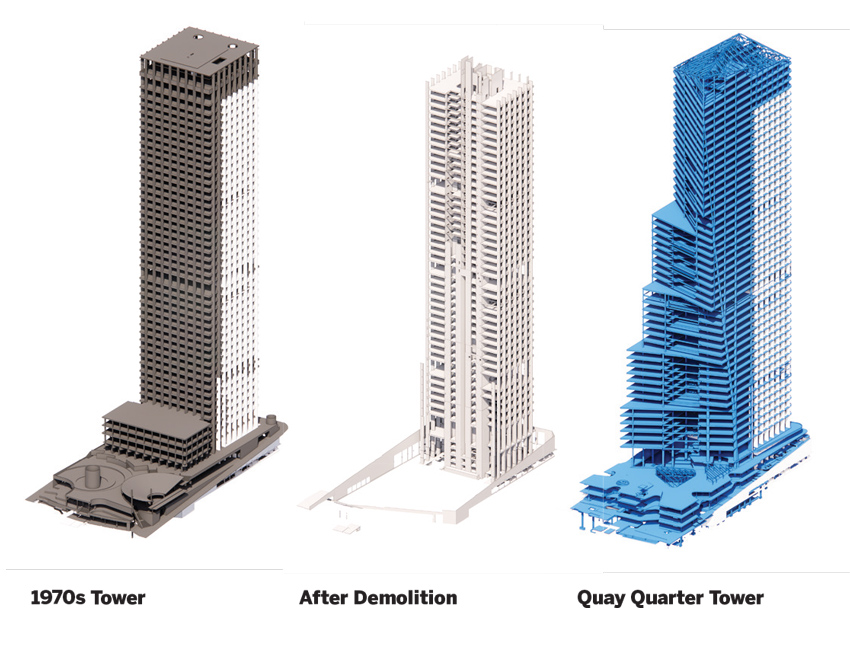View course on architecturalrecord.com »
DESIGN TEAMS have a new mission.
Over the last two decades, the operating emissions of America’s total building stock have been pared back so far that it generates a third less (and falling) than it did in 2005—even though more than 50 billion square feet of new construction have been added during that period. Thanks in no small part to design professionals’ ingenuity, the once groundbreaking feat of net zero operations is now a practical goal for nearly every new building. It’s also a necessary one, if global heating is to be capped at the internationally agreed limit of 1.5 degrees Celsius.
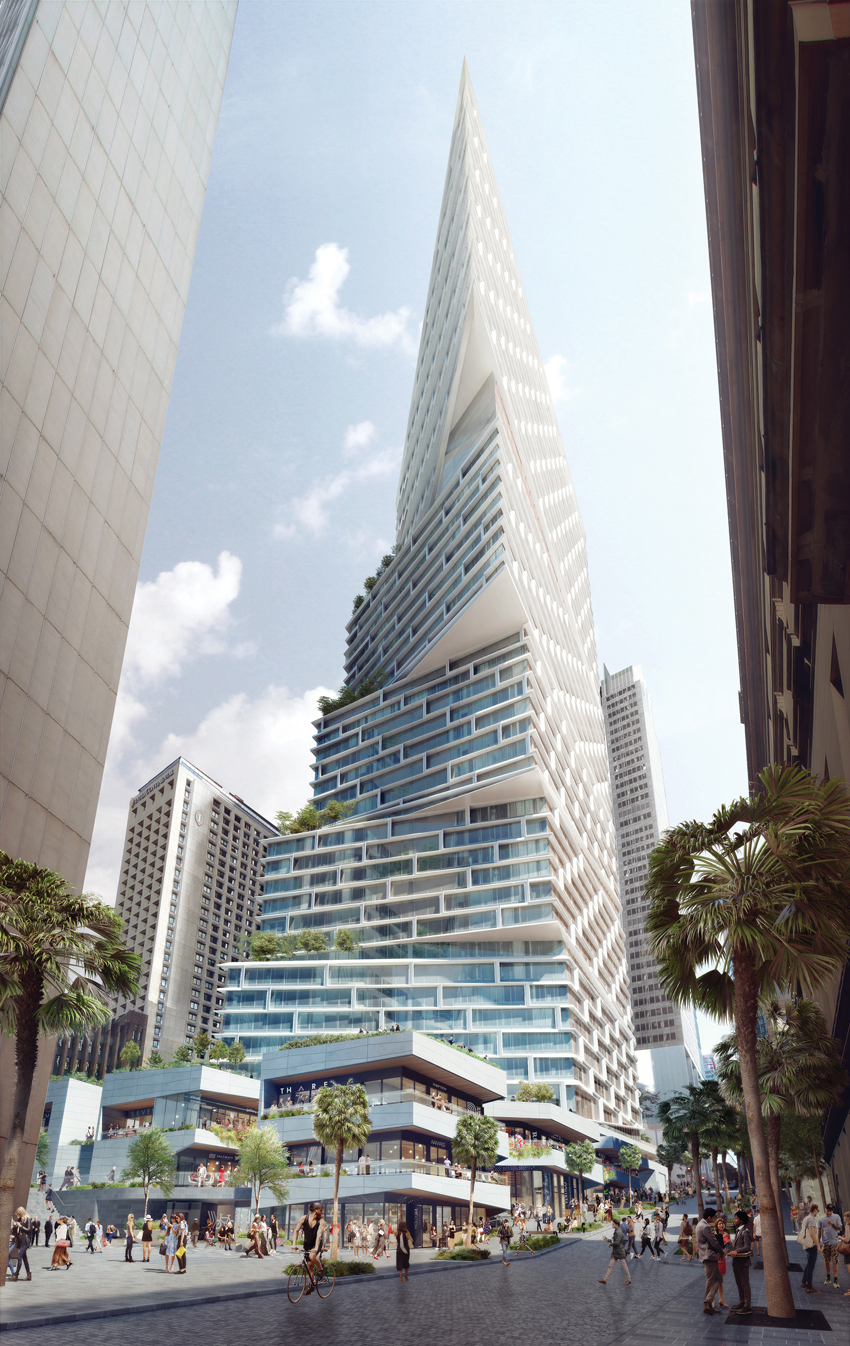
IN SYDNEY, 3XN’s 50-story Quay Quarter Tower (above) incorporates a 45-story 1970s office tower (below).
As operating emissions fall, bringing total emissions down, embodied carbon accounts for a growing proportion of what’s left. (Embodied carbon refers to greenhouse gases generated during the extraction, manufacture, and transportation of building materials, and during construction and disposal.) Worldwide, between now and 2050, embodied carbon is expected to account for over half of total greenhouse gases from all new construction, according to a 2021 report from the World Green Building Council. The fact that embodied emissions happen up front skews the short-term ratio: over the next 10 years, they are expected to account for 72 percent of the global building sector’s total. Coincidentally, a decade is about the amount of time remaining for reining in emissions this side of the 1.5 degrees Celsius limit, and avoiding the devastating climate impacts that lie beyond.
So the new mission for developers and design teams—should they choose to accept it—is to lower embodied carbon, as well as operating emissions, for a total carbon takedown. And there’s one surefire way to do it.
“Adaptive reuse is the best way to reduce embodied carbon—period,” says Andrew Rastetter, an architecturally trained structural engineer in the San Francisco office of Buro Happold. Rastetter also teaches structures at UC Berkeley’s College of Environmental Design, where he makes embodied emissions the focus of his course’s final lecture, “so it will stick,” he says. With concrete and steel the major repositories of embodied carbon in the built environment (cement manufacturing alone accounts for 8 percent of global CO2 emissions), “I want architects to understand how critically important this is. If there’s existing building infrastructure on-site, we need to consider whether there’s something we can do with it,” he says.
Three recent projects exemplify what can be accomplished when design teams prioritize embodied-carbon conservation. In Sydney, the Danish firm 3XN retained two-thirds of a 45-story tower, incorporating it into a new 50-story tower (completing in March) with double the floor area. Reusing the structure saved about 8,250 tons of greenhouse-gas emissions, equal to two years’ worth of the high-performance building’s operational emissions. It also shaved six to nine months off the demolition and construction schedule. In Los Angeles, ZGF Architects salvaged a university’s seismically damaged mid-20th-century lab building that was scheduled for demolition and upcycled it into an administrative and student-services building (2021). The project achieved an 82 percent reduction in embodied carbon compared to an equivalent new building. And in Denver, Gensler adapted a failing 1960s telecom building as a mixed-use workplace (2021), reducing embodied carbon by 68 percent of what new construction would be, while revitalizing a moribund stretch of a historic city block.
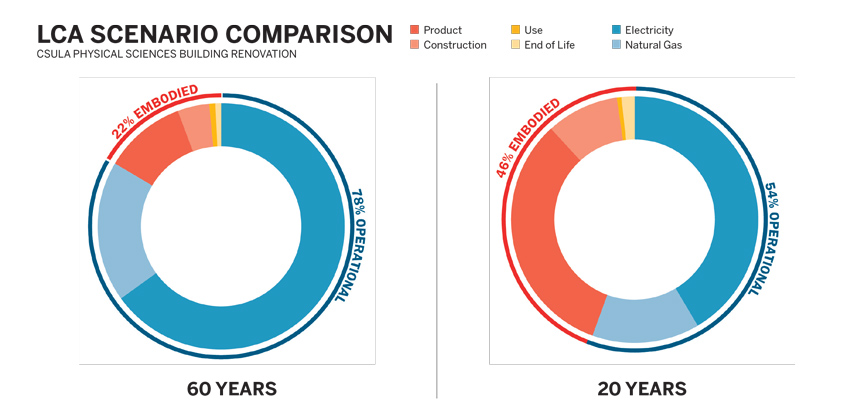
THE LCA of Atelier Ten's California State University project reveals that, over 60 years, embodied emissions account for 22 percent of total carbon. Shorten that to 20 years, and embodied emissions shoot up to 46 percent, reinforcing the importance of embodied carbon in achieving near-term reduction goals.
“A combination of regulatory and market drivers is changing the way we engage with both operational energy and embodied carbon,” says Kåre Poulsgaard, a partner and head of innovation at Copenhagen-based GXN, 3XN’s independent research and consultancy company. As a sign of the shifting regulatory context, Poulsgaard cites the Greater London Authority’s new requirement that all major projects calculate and reduce life-cycle carbon emissions, which include embodied carbon. He points to the increasingly ambitious carbon-reduction targets that clients are developing and disclosing as part of their corporate social responsibility commitments—especially as 2030 net zero commitments come due; 3XN and GXN now routinely perform a CO2 impact assessment on the firm’s large projects, comparing the carbon footprint of various construction methods and using the results to inform discussions with clients and guide design decision-making.
An early example of the firm’s work to conserve embodied carbon through adaptive reuse is Quay Quarter Tower (QQT), now approaching completion as the cornerstone of Sydney’s Circular Quay District redevelopment, near the iconic opera house. The 650-foot-high, 1.1 million-square-foot tower incorporates 65 percent of the concrete columns, beams, and slabs, and 96 percent of the core of a mid-1970s office tower, which, due to its small floor plates could no longer attract or retain tenants. The addition twists up from the existing footprint, improving views of the harbor as it rises, and doubling the floor area without expanding the original shade envelope.
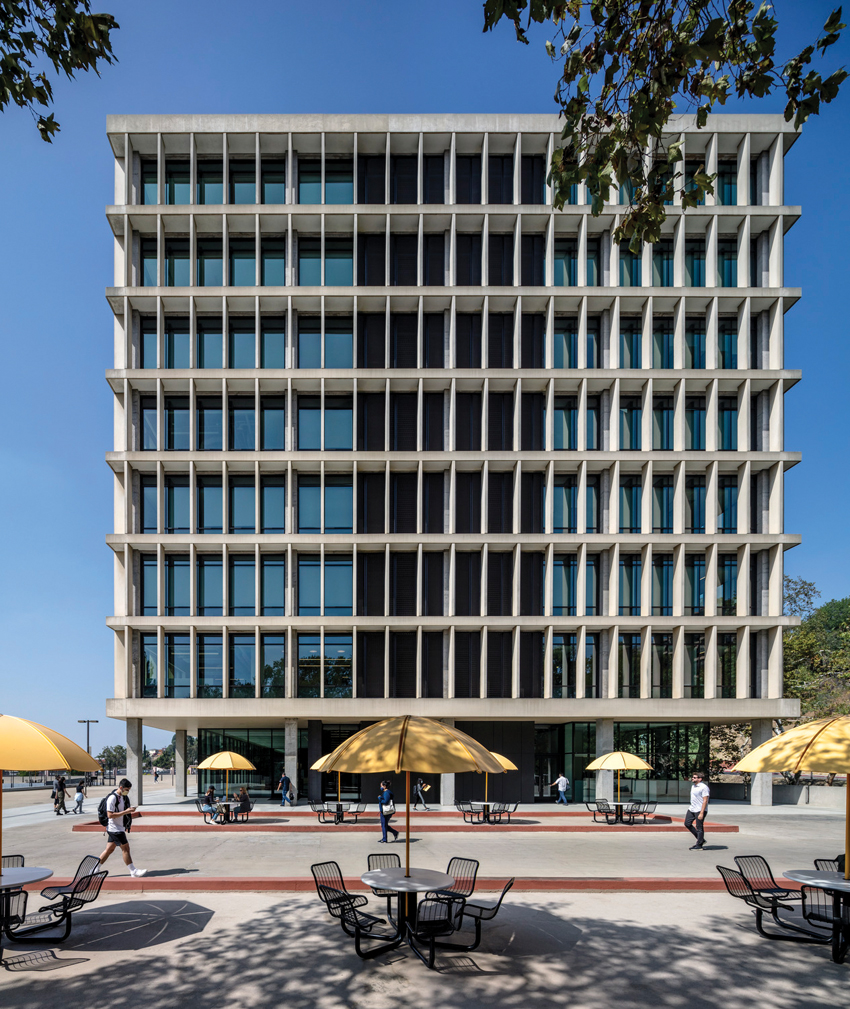
PHOTOGRAPHY: © MAGDA BIERNAT
A LAB slated for demolition on the Los Angeles campus of California State University has been upcycled into an administrative and student-services building by ZGF.
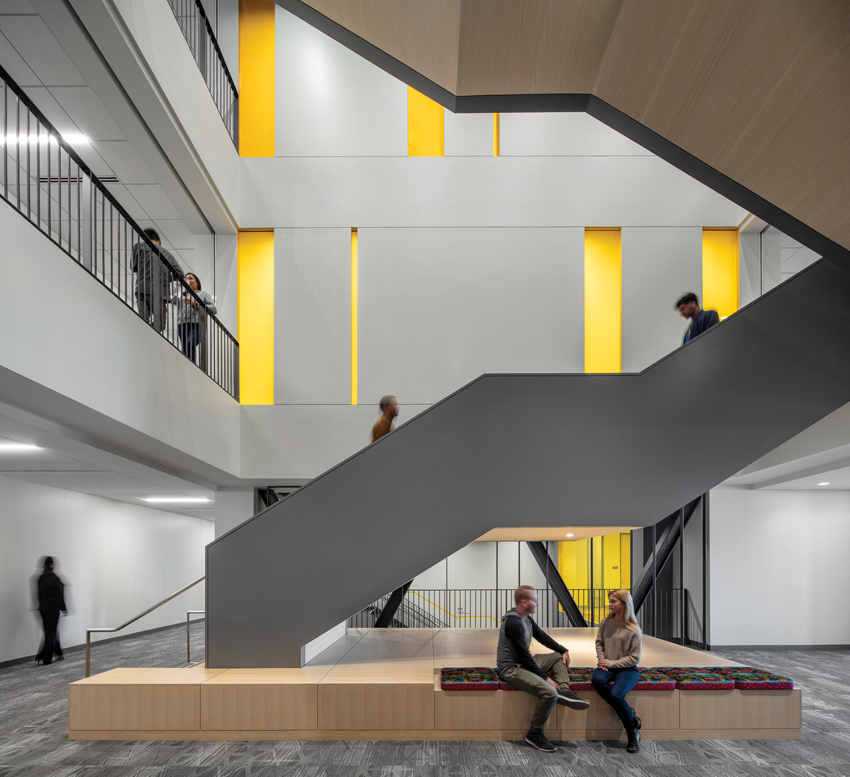
PHOTOGRAPHY: © MAGDA BIERNAT
View course on architecturalrecord.com »
DESIGN TEAMS have a new mission.
Over the last two decades, the operating emissions of America’s total building stock have been pared back so far that it generates a third less (and falling) than it did in 2005—even though more than 50 billion square feet of new construction have been added during that period. Thanks in no small part to design professionals’ ingenuity, the once groundbreaking feat of net zero operations is now a practical goal for nearly every new building. It’s also a necessary one, if global heating is to be capped at the internationally agreed limit of 1.5 degrees Celsius.

IN SYDNEY, 3XN’s 50-story Quay Quarter Tower (above) incorporates a 45-story 1970s office tower (below).
As operating emissions fall, bringing total emissions down, embodied carbon accounts for a growing proportion of what’s left. (Embodied carbon refers to greenhouse gases generated during the extraction, manufacture, and transportation of building materials, and during construction and disposal.) Worldwide, between now and 2050, embodied carbon is expected to account for over half of total greenhouse gases from all new construction, according to a 2021 report from the World Green Building Council. The fact that embodied emissions happen up front skews the short-term ratio: over the next 10 years, they are expected to account for 72 percent of the global building sector’s total. Coincidentally, a decade is about the amount of time remaining for reining in emissions this side of the 1.5 degrees Celsius limit, and avoiding the devastating climate impacts that lie beyond.
So the new mission for developers and design teams—should they choose to accept it—is to lower embodied carbon, as well as operating emissions, for a total carbon takedown. And there’s one surefire way to do it.
“Adaptive reuse is the best way to reduce embodied carbon—period,” says Andrew Rastetter, an architecturally trained structural engineer in the San Francisco office of Buro Happold. Rastetter also teaches structures at UC Berkeley’s College of Environmental Design, where he makes embodied emissions the focus of his course’s final lecture, “so it will stick,” he says. With concrete and steel the major repositories of embodied carbon in the built environment (cement manufacturing alone accounts for 8 percent of global CO2 emissions), “I want architects to understand how critically important this is. If there’s existing building infrastructure on-site, we need to consider whether there’s something we can do with it,” he says.
Three recent projects exemplify what can be accomplished when design teams prioritize embodied-carbon conservation. In Sydney, the Danish firm 3XN retained two-thirds of a 45-story tower, incorporating it into a new 50-story tower (completing in March) with double the floor area. Reusing the structure saved about 8,250 tons of greenhouse-gas emissions, equal to two years’ worth of the high-performance building’s operational emissions. It also shaved six to nine months off the demolition and construction schedule. In Los Angeles, ZGF Architects salvaged a university’s seismically damaged mid-20th-century lab building that was scheduled for demolition and upcycled it into an administrative and student-services building (2021). The project achieved an 82 percent reduction in embodied carbon compared to an equivalent new building. And in Denver, Gensler adapted a failing 1960s telecom building as a mixed-use workplace (2021), reducing embodied carbon by 68 percent of what new construction would be, while revitalizing a moribund stretch of a historic city block.

THE LCA of Atelier Ten's California State University project reveals that, over 60 years, embodied emissions account for 22 percent of total carbon. Shorten that to 20 years, and embodied emissions shoot up to 46 percent, reinforcing the importance of embodied carbon in achieving near-term reduction goals.
“A combination of regulatory and market drivers is changing the way we engage with both operational energy and embodied carbon,” says Kåre Poulsgaard, a partner and head of innovation at Copenhagen-based GXN, 3XN’s independent research and consultancy company. As a sign of the shifting regulatory context, Poulsgaard cites the Greater London Authority’s new requirement that all major projects calculate and reduce life-cycle carbon emissions, which include embodied carbon. He points to the increasingly ambitious carbon-reduction targets that clients are developing and disclosing as part of their corporate social responsibility commitments—especially as 2030 net zero commitments come due; 3XN and GXN now routinely perform a CO2 impact assessment on the firm’s large projects, comparing the carbon footprint of various construction methods and using the results to inform discussions with clients and guide design decision-making.
An early example of the firm’s work to conserve embodied carbon through adaptive reuse is Quay Quarter Tower (QQT), now approaching completion as the cornerstone of Sydney’s Circular Quay District redevelopment, near the iconic opera house. The 650-foot-high, 1.1 million-square-foot tower incorporates 65 percent of the concrete columns, beams, and slabs, and 96 percent of the core of a mid-1970s office tower, which, due to its small floor plates could no longer attract or retain tenants. The addition twists up from the existing footprint, improving views of the harbor as it rises, and doubling the floor area without expanding the original shade envelope.

PHOTOGRAPHY: © MAGDA BIERNAT
A LAB slated for demolition on the Los Angeles campus of California State University has been upcycled into an administrative and student-services building by ZGF.

PHOTOGRAPHY: © MAGDA BIERNAT
The new structure consists of concrete-filled steel-tube columns and steel beams grafted onto the existing concrete framework. To prevent differential settlement of the old and new floor plates from fracturing the slabs, with knock-on damage to the facade, the construction team left a gap of one structural bay between the old and new elements, completing the connections after the new structure had settled.
With the aim of humanizing the high-rise, the building is organized as a series of “vertical villages” connected by atria and outdoor terraces. To allow for future change, floors above and below the atria are designed to be removed post-occupancy if tenants want to extend their “village.” With bolted connections, the flex floors can be disassembled and taken down the service elevator.
The building’s mixed-use, three-level podium, with a market hall and publicly accessible rooftop park, is aimed at re-energizing the surrounding neighborhood. “Adaptive reuse is also a form of urban sustainability,” says Sydney-based 3XN partner Fred Holt. He describes a devolution in which assets age and lose value, owners stop investing, the district deteriorates, attracting less attention and investment from the municipality, and new builds start to push toward cities’ outer edges, where infrastructure must then be extended, emitting yet more carbon. “QQT’s adaptive reuse allowed us to reinvigorate not only an asset that was losing value,” he says, “but also an existing precinct within the city, thus reducing indirect CO2 from further expansion.”
A similar rationale of conservation through minimization underpinned ZGF’s proposal to upgrade what was initially intended only as a swing space on the Los Angeles campus of California State University. An eight-story, 218,000-square-foot vacant laboratory building had been damaged in the 1994 Northridge earthquake, and the university’s original brief envisioned a seismic retrofit, hazardous-materials abatement, and new finishes to accommodate an administrative and student-services center just until a new building could be completed: at that point the former lab building would be demolished.
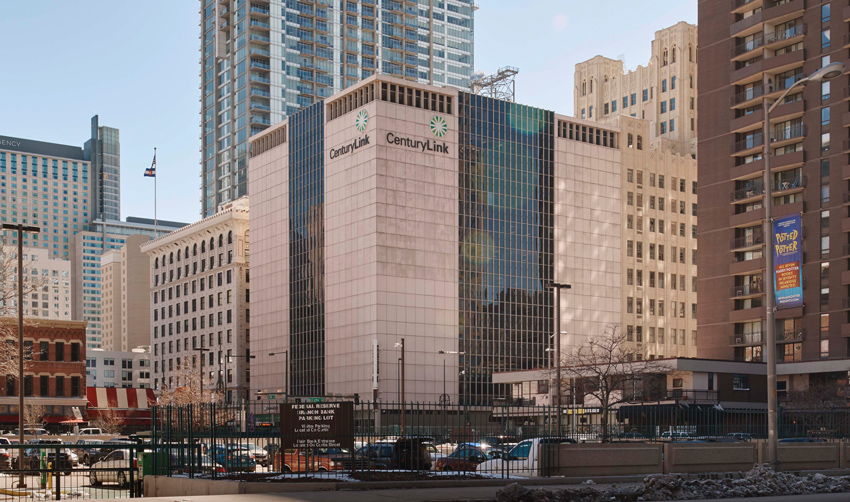
PHOTOGRAPHY: © GENSLER/RYAN GOBUTY
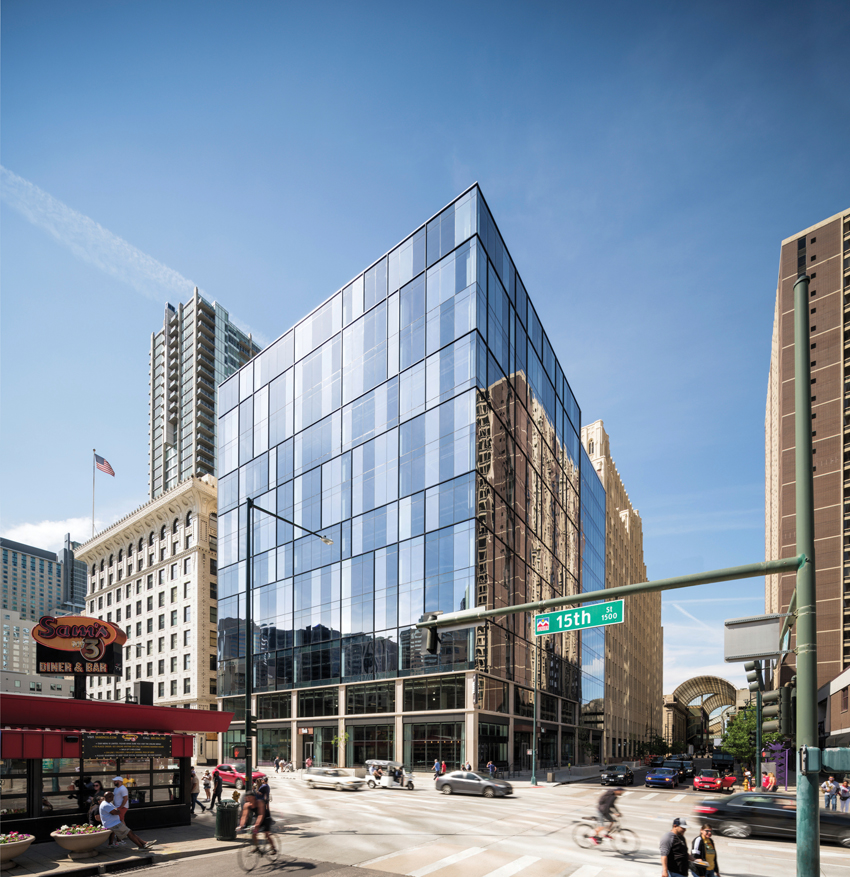
PHOTOGRAPHY: © DAVID LAUER
AS PART of a transformation of a vacant telecom building (top) in Denver into office space, Gensler has replaced its Brutalist cladding with a new facade (above).
Instead, ZGF proposed that, by investing in a more comprehensive renovation, the university could eliminate the need for a new building, and the cost of demolition and time, money, materials, and effort would not be wasted on a temporary space. “Five or six years ago, embodied carbon was not on many people’s radar,” says Amy Leedham, an architect in the San Francisco office of Atelier Ten, the project’s environmental consultant, “but even if we weren’t using that term, implicitly we all understood that salvaging this building for a good long-term use would be an embodied-carbon win.”
In addition to the seismic retrofit, scope for the new Administrative and Student Services Building, completed in 2021, included new windows, roofing, building services and controls, and security, as well as interior configuration, finishes, fixtures, and equipment, with a series of studies by Atelier Ten and ZGF guiding the major moves. The first set of analyses, conducted during schematic design, informed the facade design. Another set early in design development focused on interior design recommendations to optimize daylight, and a final set at the end of construction quantified the total achievement. “One of the challenges that’s unique to adaptive reuse is meaningful operational improvements,” says Leedham. “Without a complete re-skin and mechanical-system upgrade, embodied-carbon savings may not make up the loss from operational compromises over the life of the building. But here we have the best of both.”
A life cycle assessment (LCA) uses scientifically validated methods to tally resource inputs and emissions—to air, soil, and water—and to quantify a project’s overall environmental loads from cradle to gate, or cradle to grave, depending on the type of analysis undertaken. (Among the reasons a team might choose one method over another is the fact that popular third-party certifications, such as LEED and the Living Building Challenge, have different requirements.) The Cal State renovation’s LCA reveals that, over a 60-year period, the adaptive reuse will reduce the building’s total carbon by 37 percent compared to code-compliant new construction. Over that period, the embodied carbon of the renovation, which includes core and shell elements but not MEP (a scope which is still difficult to capture, due to a lack of manufacturer transparency), accounts for 22 percent of the building’s total carbon footprint. Shorten the period to 20 years, however, and embodied carbon’s share shoots up to almost half, reiterating its importance in achieving near-term emissions reduction goals. In another analysis of the project’s conservation achievement, operational savings recouped the embodied carbon of the renovation in two years; an equivalent new building would have taken 10.
In the five or so years since the CSULA renovation was designed, awareness of embodied carbon and the ability to measure it has improved. “If we were doing it now, we would probably do significant interior-finish analysis during design development,” says Leedham. “Five years ago, there wasn’t enough data transparency from manufacturers to be able to do that, but now for primary interior-finish materials, there definitely is—though more advancement in transparency will only make the process easier.”
The ease with which it’s now possible to perform life-cycle assessments was a key takeaway from Gensler’s transformation of a 12-story, 230,000-square-foot vacant telecom building into a contemporary workplace on a corner lot in downtown Denver, says Alex Garrison, design director at the firm’s local office. Big moves in the renovation of the Link, as the building is known, included replacing its Brutalist concrete panels and ribbon windows with high-performance glazing and operable windows, cladding the first two stories with stone, and creating tenant-ready interiors with concrete floors, open ceilings, and an array of amenities. Datum lines that relate to adjacent historic buildings help stitch the Link into its context, and the building’s new ground-level retail, café, conference center, and lobby are re-animating the neighborhood.
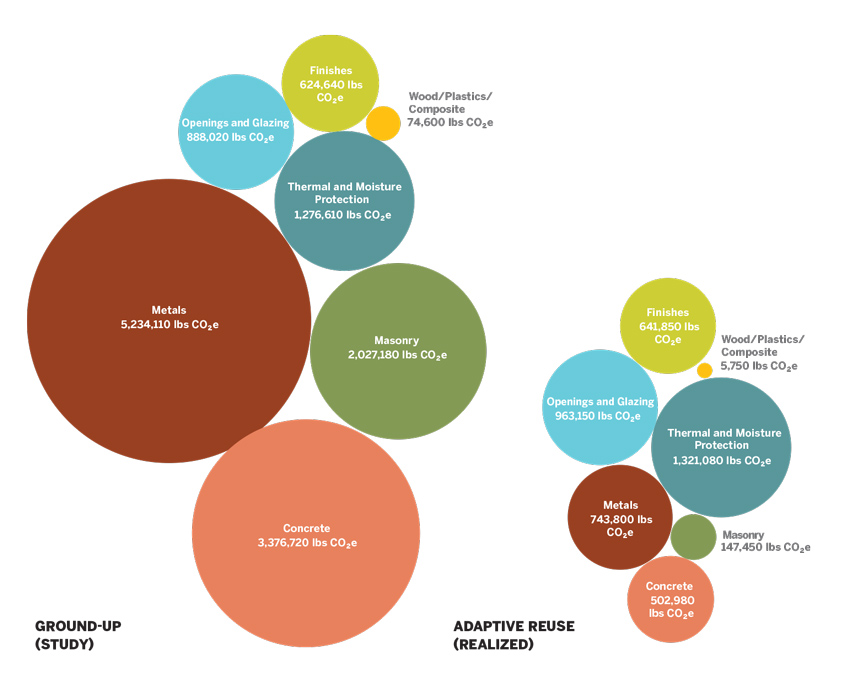
ONE ANALYSIS conducted for the LCA of Gensler’s Denver renovation compares the embodied footprints of new construction and adaptive reuse and the relative contribution of each material.
Gensler conducted an LCA of the completed project to quantify its embodied-carbon achievement. The aim was to provide a basis for conversations with clients, municipalities, and business associations about the significance and opportunity of adaptive reuse.
The LCA tool “is like a force multiplier,” says Garrison, describing the ease with which he was able to compare materials and generate analyses. “It makes you much more effective.” With a BIM plug-in (Tally) that uses a custom-designed database combining material attributes, assembly details, and architectural specifications with environmental-impact data, Garrison calculated the embodied-carbon footprint of the Link’s architectural components—curtain wall and enclosure, structure, thermal and moisture protection, masonry, and finishes—at about 2,165 tons of carbon dioxide equivalents (CO2e), a 68 percent reduction in embodied carbon compared with a baseline new build’s 6,750 tons. The most substantial savings came from the reuse of the steel-and-concrete structure.
“It’s opening people’s eyes to the potential to reimagine these old buildings,” says Garrison, “and it’s got clients thinking about older buildings in their portfolios or buildings that may be targets for acquisition.”
In addition to the fee-based tool that Gensler used, a number of alternatives are freely available. Buro Happold has developed the Buildings and Habitats object Model (BHoM) Life Cycle Assessment Toolkit, free, open-source software that won a 2020 AIA Innovation Award. It enables users to access BIM data from a variety of programs, move the data into other software environments, such as a visual programming tool or a spreadsheet, and export the results to visualization engines or databases. “It provides transparency in terms of what the tool is doing, and flexibility in terms of where we draw data from and the environmental product declarations that we put into it,” says Rastetter, “but it does require some level of experience with programming tools.”
Another free tool is the Embodied Carbon in Construction Calculator (EC3), developed with input from some 50 industry partners and administered by the nonprofit Building Transparency (which now also administers Tally). EC3 draws on a database of thousands of third-party-verified Environmental Product Declarations (EPDs), enabling teams to compare the embodied carbon of alternative products, and to evaluate projects’ embodied emissions based on material quantities from construction estimates or BIM. Building Transparency is in the process of integrating this database with Tally’s, although EC3 will continue as a stand-alone product, especially useful for project teams that don’t rely on BIM, or on the particular BIM software with which Tally is compatible.
The greater the portion of an existing asset that can be incorporated into a redevelopment, the greater the conservation of embodied energy, but even retaining just the below-grade structure can reduce the concrete needed for a new building by a significant amount—as much as 25 percent, suggests 3XN’s Holt. The new superstructure will typically provide a larger floor area, but those existing below grade levels may well be adequate as cities worldwide cut back on parking requirements. In whole or in part, reusing buildings that are past their functional prime, but whose materials are still viable, offers the potential for dramatic savings in building-sector emissions over the next 10 crucial years. As Quay Quarter Tower, CSULA’s Administrative and Student Services Building, and the Link illustrate, “upcycling the majority of the structure of an existing building expresses an innovative vision for sustainable building in dense urban areas,” says Holt, “one that sets an example for developers and city builders across the globe.”
Supplemental Materials:
Bringing Embodied Carbon Upfront: Coordinated action for the building and construction sector to tackle embodied carbon,
© World Green Building Council, September 2019. (Through page 13)

